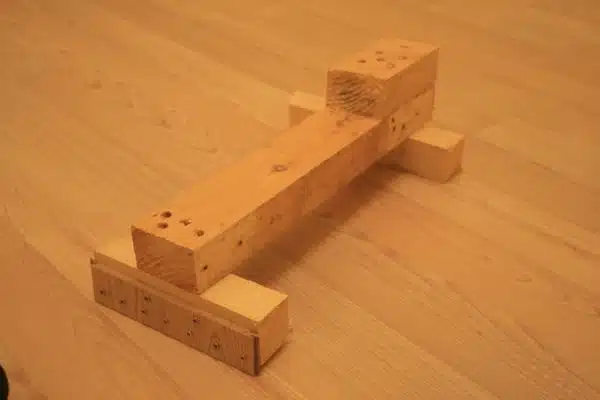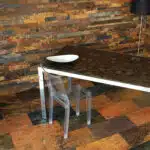Installing laminate flooring is a popular choice for homeowners looking to update the look and feel of their homes. The process of installation can seem daunting at first, but with the right tools and know-how, it’s a task that can be accomplished by even novice DIYers. As an expert in laminate flooring installation, I am here to guide you through the process step-by-step and provide you with all the necessary information to ensure your project is successful.
In this article, we’ll cover everything you need to know about installing laminate flooring, from preparation to finishing touches. We’ll start with an overview of the different types of laminate flooring available and what factors to consider when choosing one. Then, we’ll move on to preparing your subfloor for installation and how to properly measure and cut your planks. Finally, we’ll discuss important finishing touches such as trim and baseboards, leaving you with a completed project that will leave your home feeling refreshed and modern. Let’s get started!
Benefits Of Laminate Flooring
Laminate flooring is a popular choice among homeowners for its many advantages. One of the most significant benefits is its affordability compared to other flooring options. Laminate flooring is generally less expensive than hardwood, tile, or carpet, making it an attractive option for those on a budget.
Another advantage of laminate flooring is its durability. It can withstand heavy foot traffic and resist scratches, dents, and stains better than some other types of flooring. Additionally, laminate floors are easy to clean and maintain with regular sweeping or vacuuming and occasional mopping.
Despite these advantages, laminate flooring also has its disadvantages. It may not last as long as hardwood or tile and may need to be replaced sooner. And while it can mimic the look of natural materials like wood or stone, some people may find it lacks the depth and texture of the real thing. However, when considering factors such as cost-effectiveness and ease of installation, laminate flooring emerges as a sensible choice for many homeowners seeking an attractive and practical flooring solution.
Moving on to the next section about types of laminate flooring…
Types Of Laminate Flooring
After exploring the benefits of laminate flooring, it is time to delve into the different options available. Laminate floors come in a variety of styles, colors, and finishes. From traditional wood-look to stone-look and even tile-look, there is a style that will fit any home décor. In addition, laminate flooring can be installed using various methods such as click-and-lock or glue-down options.
One of the most significant advantages of laminate flooring is its durability, making it an ideal option for high-traffic areas. Laminate flooring is resistant to scratches, dents and stains, which makes it perfect for households with pets and children. It also has superior moisture resistance when compared to traditional hardwood floors. Additionally, laminate floors are easy to maintain and can last for many years if they are correctly installed and cared for.
When considering the right type of laminate flooring for your home or office space, it is essential to consider factors such as foot traffic levels and personal preferences. Some laminate flooring options have thicker wear layers than others, making them more durable in high traffic areas like entryways and hallways. Others may have unique finishes that provide extra traction or slip resistance in wet areas such as bathrooms or kitchens. Ultimately, choosing the right laminate floor will depend on your individual needs and taste preferences.
Choosing The Right Laminate Flooring
When it comes to choosing the right laminate flooring for your home, there are several factors to consider. One of the most important considerations is the variety of flooring options available in the market. Laminate flooring comes in different colors, textures, and finishes. You should choose a style that matches the existing décor of your home.
Another crucial factor to think about is budget considerations. Different brands offer varying prices for their laminate flooring products. It’s important to keep in mind that cheaper options may not last as long or have as high-quality materials compared to more expensive ones. However, this doesn’t mean that you should always go for the most expensive option. Instead, you should weigh up your budget with durability and quality when making a decision.
To help you make an informed decision, here are four things to keep in mind when choosing laminate flooring:
- Durability – Look for laminates with higher AC ratings.
- Material – Choose a laminate made of HDF (High-Density Fiberboard) core.
- Thickness – Thicker laminates are usually more durable.
- Design – Choose a design that complements your current interior décor.
With these considerations in mind, you can narrow down your options and choose the best laminate flooring for your space and budget before moving on to measuring your space accurately for installation purposes.
Measuring Your Space
Accurate measurements of the room are necessary before beginning a laminate flooring installation. Careful calculations of the required amount of laminate material are also essential to ensure that the necessary amount is purchased. Using a tape measure, it is important to measure the length, width, and the square footage of the room. Additionally, one should factor in any waste materials to account for irregularities in the size and shape of the room.
Measuring The Room
Measuring the Room is a crucial step in installing laminate flooring. It is important to ensure accuracy when measuring the room to avoid any issues during installation. As an expert in laminate flooring installation, I recommend taking the time to measure each wall and corner of the room multiple times to ensure precision.
When measuring, it is also essential to consider furniture placement. Take note of any large pieces of furniture that may need to be moved or removed from the room prior to installation. This will allow for a smoother and more efficient installation process. It is also important to factor in any gaps needed between the wall and flooring for expansion and contraction purposes.
Inaccurate measurements can lead to a number of issues, including uneven flooring and gaps between planks. These issues can be costly and time-consuming to fix. To ensure a successful laminate flooring installation, take the necessary time and care when measuring the room. By doing so, you’ll save yourself from potential headaches down the line and enjoy beautiful new floors for years to come!
Calculating The Required Amount Of Laminate
Once you have accurately measured the room, the next step in installing laminate flooring is to calculate the required amount of laminate. This is an essential task that must be done with precision to avoid any shortage or waste of materials. As a professional installer, I recommend calculating the total square footage of the room by multiplying the length and width measurements obtained during the measuring process.
When calculating the required amount of laminate, it’s crucial to take into account potential waste and adjustments for irregularities in the room. Factors such as angled walls and doorways can affect how much material is needed. I suggest adding 10% additional material to your total square footage calculation to account for waste and any necessary adjustments.
To ensure accuracy, it’s also essential to consider the pattern layout when calculating the required amount of laminate. This will help determine how many planks are needed and whether any cuts or wastage will occur. Taking these additional steps before purchasing your flooring will save time and money in the long run by ensuring that you have enough material on hand for a successful installation.
Preparing Your Subfloor
Subfloor preparation is a crucial step in installing laminate flooring. Before starting the installation process, you must ensure that your subfloor is clean, level, and dry. Any unevenness or dirt on the subfloor can lead to problems later on.
The first step in subfloor preparation is to remove any existing flooring material. If you have carpet, use a pry bar and pliers to remove it entirely. Then, use a scraper or floor buffer to remove any adhesive residue. If you have other types of flooring materials like tile or hardwood, remove them with appropriate tools.
After removing the existing flooring material, you need to check for moisture levels in the subfloor. High moisture levels can cause swelling and warping of the laminate planks over time. You can use a moisture meter to test the moisture content of your subfloor. Ideally, the moisture content should be below 12% before installing laminate flooring.
In summary, subfloor preparation is an essential step in installing laminate flooring. It involves removing any existing flooring material and checking for moisture levels in the subfloor. By following these steps carefully, you can ensure that your new laminate floor will last for many years without any issues related to poor subfloor preparation. In the next section about ‘tools you’ll need,’ we will discuss some essential tools required for installing laminate flooring efficiently and accurately.
Tools You’ll Need
Before beginning any laminate flooring installation project, it is essential to gather the necessary tools to ensure a smooth and efficient process. Safety precautions must also be taken into account when working with power tools and sharp objects. Always wear protective gear such as gloves, goggles, and a dust mask.
The primary tools required for installing laminate flooring include a circular saw, jigsaw, miter saw, drill, measuring tape, hammer, pry bar or pull bar, tapping block, spacers, and a utility knife. It is imperative to use these tools correctly to avoid injury or damage to the flooring material. If you do not have access to these specific tools, there are alternative methods that can be used in their place.
When using power tools such as the circular saw or jigsaw for cutting laminate planks, always follow manufacturer instructions and handle with care. Do not attempt to force the tool through the material as this could cause kickback or damage to the blade or motor. When using manual tools like the tapping block or pry bar/pull bar for fitting planks together tightly without damaging them or causing gaps between them.
Moving forward into underlayment installation requires additional materials and tools that will provide sound insulation and moisture protection for your new laminate flooring.
Underlayment Installation
- To prepare the floor for laminate flooring, it is important to sweep and vacuum the surface to remove any dirt and debris that may be present.
- The underlayment should then be installed, making sure to line up any seams with the edge of the flooring.
- Installation of the underlayment should be done in rows and can be secured with tape or staples.
- It is important to leave a small gap between the edges of the underlayment and walls to allow for expansion.
- The underlayment should be cut to fit around any obstacles such as doorways or stairs using a utility knife or scissors.
- Once the underlayment is installed and secured, the laminate flooring can be laid in place.
Preparing The Floor
When it comes to installing laminate flooring, preparing the floor is an essential step that should not be overlooked. One of the first things you need to consider is the type of flooring alternative you want to use. Laminate flooring can be installed over a variety of subfloor materials, including concrete, plywood, and vinyl. However, it’s important to check with your manufacturer’s instructions to ensure that the subfloor meets their requirements.
Before installing the underlayment, it’s necessary to prep the floor surface by removing any existing flooring or debris. This will provide a clean and even surface for the laminate flooring installation. If there are any bumps or unevenness in the subfloor material, they will need to be sanded down or filled in before proceeding with underlayment installation.
Once you have ensured that your subfloor is ready for installation, it’s time to lay down your chosen underlayment material. There are several types of underlayment available on the market today, including foam and cork options. Consider factors such as noise reduction and moisture protection when selecting your underlayment material. By taking these crucial steps in preparing your floor surface and selecting appropriate underlayment materials, you can ensure a successful and long-lasting laminate flooring installation.
Installing The Underlayment
Now that we have discussed the importance of preparing the floor surface, let’s move on to the next crucial step in laminate flooring installation – installing the underlayment. The underlayment is a thin layer of material that serves as a cushion between your subfloor and laminate flooring. It helps to reduce noise, absorb impact, and protect against moisture.
To install the underlayment, you will need a few essential tools such as a tape measure, utility knife, and duct tape. One common mistake people make during this process is not allowing enough overlap between sections of underlayment. It’s important to ensure that each section overlaps by at least 2-3 inches to prevent any gaps or separation.
When selecting your underlayment material, consider factors such as thickness and moisture resistance. Foam and cork are popular options due to their sound-dampening properties, but they may not be suitable for areas prone to moisture buildup. Always refer to your manufacturer’s instructions for guidance on selecting appropriate underlayment materials. By taking these steps in installing the underlayment correctly, you can help ensure a smooth and long-lasting laminate flooring installation.
Securing The Underlayment
With the underlayment properly installed, the next step is to secure it in place. This is an important step as it helps to prevent any movement or shifting of the underlayment, which can lead to uneven flooring and potential damage. One crucial factor to consider when securing the underlayment is the importance of a moisture barrier. Moisture can seep through even the smallest gaps between your subfloor and underlayment, leading to mold growth and warping of your laminate flooring.
To ensure a smooth and long-lasting installation, there are several tips you should keep in mind when securing your underlayment. Firstly, be sure to use duct tape to seal all seams between sections of underlayment securely. This will help to prevent any moisture from seeping through and damaging your subfloor or flooring. Additionally, ensure that you do not overlap sections too much as this can create lumps or bumps in your flooring.
Another tip is to use staples or adhesive to secure the underlayment in place. Staples are ideal for wooden subfloors as they provide a strong hold without damaging the wood. Adhesive is suitable for concrete subfloors as it creates a strong bond that prevents any movement of the underlayment. By following these tips, you can help ensure that your underlayment stays securely in place and provides optimal protection against moisture buildup.
Laying The First Row Of Planks
When laying the first row of planks for your laminate flooring, there are several starting row tips you should keep in mind. First, ensure that the wall you will begin laying the planks against is straight and even. If it is not, you may need to adjust the plank length accordingly by cutting off a small section from the end of the first plank.
After ensuring that your starting wall is straight, begin laying your planks left to right across the room. As you lay each plank, use spacers to maintain an even gap between it and the adjacent wall. This gap allows for expansion and contraction of the flooring due to changes in temperature and humidity. Once you have laid all of the planks in the first row, use a tapping block and hammer to secure them firmly together before moving on to subsequent rows.
Now that you have successfully laid your first row of planks, it’s time to move on to installing the rest of your laminate flooring. Keep in mind that adjusting plank length may be necessary as you continue working through each row, particularly if you encounter any obstacles or uneven walls along the way. With careful attention to detail and a willingness to make adjustments as needed, however, you can achieve beautiful results with your new laminate flooring installation.
Installing The Rest Of Your Laminate Flooring
- Before installing laminate flooring, it is important to properly prepare the subfloor by ensuring it is clean, level, and dry.
- Once the subfloor is prepared, the laminate planks can be installed by connecting them together using a tongue-and-groove system and tapping them into place with a tapping block and mallet.
- The edges of each plank should be secured with a suitable adhesive, such as a construction adhesive or flooring glue.
- Lastly, the planks should be secured to the subfloor with a suitable flooring nailer or stapler.
Preparing The Subfloor
Before installing laminate flooring, it is crucial to prepare the subfloor properly. This step ensures that the flooring will lay flat and last for many years. Moisture barriers are an essential component of preparing the subfloor for laminate flooring installation. A moisture barrier prevents moisture from penetrating the subfloor and causing damage to your new floor. It is important to note that not all subfloors require a moisture barrier. However, if you are installing over concrete or any other surface that may have moisture issues, a moisture barrier is necessary.
Subfloor repair is another important aspect of preparing the subfloor for laminate flooring installation. Any damage to the subfloor needs to be repaired before laying the new floor. Otherwise, you risk creating unevenness in your floor, which can lead to cracks and other issues down the road. Before repairing any damaged areas, ensure that the subfloor is clean and free of debris. Then, use a suitable filler material or plywood to fill in any gaps, holes or cracks in your subfloor.
In conclusion, preparing the subfloor correctly is critical when installing laminate flooring. Moisture barriers protect against moisture-related damage while repairing any damages ensures an even surface for your new flooring. By following these steps carefully, you can help ensure a smooth and long-lasting installation of your laminate floors.
Installing The Laminate Planks
Now that the subfloor is prepared, it’s time to move on to the installation of the laminate planks. The first step is to decide on the direction in which you will lay your planks. This decision can have a significant impact on the finished look of your floor. Most commonly, planks are laid parallel to the longest wall in the room for a more aesthetically pleasing result. However, there is no hard and fast rule about plank direction, so feel free to experiment with different layouts and patterns.
Once you have decided on your plank direction, it’s time to start installing them. Begin by cutting the planks to fit around any obstacles in the room such as doorways or heating vents. There are several cutting techniques available depending on your tools and skill level, including saws and laminate cutters. It’s crucial to measure carefully and make precise cuts to ensure a tight fit between planks.
As you install each row of planks, be sure to stagger them for a more natural appearance. You can achieve this by starting each new row with a shorter plank than the previous one or by using a random pattern of plank lengths. Finally, use spacers between each plank and along the edges of the room to allow for expansion and contraction due to temperature changes. With careful attention paid to these details, your laminate flooring installation will be seamless and long-lasting.
Cutting Laminate Flooring
Once you have measured and marked the laminate flooring to fit your space, the next step is cutting it to size. Cutting laminate flooring is an essential part of the installation process, and it requires specific techniques and tools to ensure a clean and precise cut.
One of the most common techniques for cutting laminate flooring is using a circular saw or jigsaw. A circular saw allows for straight cuts, while a jigsaw can make curved cuts or intricate shapes. Whichever tool you choose, be sure to use a fine-toothed blade designed for laminate flooring. This will reduce chipping and ensure a smooth cut.
Another option for cutting laminate flooring is using a handsaw or handsaw with a miter box. This method may take longer than using power tools but can be useful in smaller spaces or when precision is crucial. Additionally, if you are installing around doorways or other obstacles, a handsaw may be the best option as it provides more control over the cut.
| Tool | Purpose |
|---|---|
| Circular Saw | Straight cuts |
| Jigsaw | Curved cuts or intricate shapes |
| Handsaw | Precision cuts in small spaces |
| Miter Box | Provides support for hand saw |
Cutting laminate flooring requires careful attention to detail and precision to ensure that each piece fits seamlessly together. Once your pieces are cut to size, you can move on to fitting them around doors and other obstacles in your space.
Fitting Laminate Flooring Around Doors
After properly cutting the laminate flooring pieces, it’s time to fit them around doors. Doorframe challenges are a common issue when installing laminate flooring, but there are DIY solutions that can make the process easier. One option is to use a jigsaw or handsaw to cut the flooring to fit around the doorframe. Another solution is to remove the doorframe and install the flooring underneath, then reinstall the frame.
When fitting laminate flooring around doors, it’s important to keep in mind the need for matching patterns seamlessly. This means that when cutting and fitting pieces of laminate, you should pay attention to how they will align with adjacent pieces and ensure that any seams are as unnoticeable as possible. To achieve this, consider using a tapping block and pull bar during installation to lock pieces together tightly.
With these tips in mind, you can tackle any doorframe challenges that may arise during your laminate flooring installation project. Remember to take your time and measure twice before making any cuts or installations. Once all of your pieces are fitted snugly into place, it’s time for the finishing touches: baseboards and trim.
Finishing Touches: Baseboards And Trim
The finishing touches of any laminate flooring installation project can make a significant difference in its overall appearance. Baseboards and trim serve as the final piece of the puzzle, adding a polished look to your new floors while hiding any gaps or imperfections between the flooring and wall. When choosing baseboards and trim, there are various color options available that can complement your existing decor or create a fresh new look.
DIY enthusiasts may be tempted to take on baseboard and trim installation themselves, but it’s important to note that this step requires precision cutting and measuring. Hiring a professional ensures that the job is done correctly with minimal room for error. Additionally, professionals have access to specialized tools and equipment that can make the process more efficient.
Ultimately, whether you choose to install baseboards and trim yourself or hire a professional will depend on your skill level and budget. Regardless of which option you choose, taking care during this step ensures that your laminate flooring looks flawless once complete. In the next section, we’ll discuss cleaning and maintenance tips to keep your new floors looking great for years to come.
Cleaning And Maintenance
- Cleaning laminate flooring is best done with a light damp mop or sponge and a mild cleaning solution.
- Stains on laminate flooring can be removed using a soft cloth and a mild cleaner such as rubbing alcohol or white vinegar.
- Polishing laminate flooring should be done regularly for optimal results.
- A laminate floor polish should only be used on a clean floor and applied in a thin, even coat.
- After polishing, the floor should be allowed to dry for at least 15 minutes before being walked on.
- For maximum shine and protection, a laminate floor may be waxed, but this should be done with caution as wax can dull and discolor the floor.
Cleaning
Maintaining the appearance of your laminate flooring is crucial to keep it looking new and fresh for years to come. One of the most important steps in maintaining your laminate flooring is cleaning it properly. Knowing how to properly clean laminate flooring can help you avoid damaging it and keep its shine intact.
The first step in cleaning your laminate flooring is to remove any dirt or debris from the surface using a broom or vacuum cleaner. Once you have removed all the loose dirt, use a damp mop or cloth to wipe down the floor. Avoid using excessive water as this can cause damage to the floorboards. Instead, use a damp mop with mild soap or vinegar solution which will not only clean but also disinfect the surface.
To maintain the appearance of your laminate flooring, there are some tips that you should follow. Firstly, avoid walking on it with high heels or shoes that have sharp edges as they can scratch and damage the surface. Secondly, place mats at entryways to trap dirt and debris from outside before coming inside. Lastly, avoid exposing your laminate flooring to direct sunlight for prolonged periods as this can cause fading and discoloration over time. By following these tips along with proper cleaning techniques, you can keep your laminate flooring looking new and beautiful for many years to come!
Removing Stains
When it comes to maintaining your laminate flooring, proper cleaning is crucial. However, even with regular cleaning, accidents happen and stubborn stains can appear on the surface. Removing these stains can be challenging, but with the right techniques and products, it is possible to restore your flooring’s shine.
To remove stubborn stains from your laminate flooring, start by identifying the type of stain and choosing the appropriate cleaning solution. For example, grease stains can be removed using a mixture of hot water and dish soap, while ink stains require rubbing alcohol or acetone. Apply the solution to a clean cloth and gently rub the stain in a circular motion until it disappears. Be careful not to use excessive force or abrasive tools that can damage the surface of your flooring.
Preventing future stains is just as important as removing existing ones. To minimize the risk of staining your laminate flooring, avoid spilling liquids on it and clean up any spills immediately using a damp cloth. Place mats under furniture legs to prevent scratches and use protective pads when moving heavy objects across the floor. By following these tips and regularly cleaning your laminate flooring, you can maintain its appearance for years to come.
In conclusion, removing stubborn stains from laminate flooring requires patience and care. With proper techniques and cleaning solutions, however, you can restore its shine and keep it looking new. Remember to also take steps to prevent future stains by being cautious with liquids and protecting your floor from scratches. By doing so, you will ensure that your laminate flooring remains beautiful for years to come!
Polishing
Maintaining laminate flooring involves regular cleaning and addressing stubborn stains. However, beyond these basic steps, it’s also essential to consider the importance of polishing techniques in preserving its appearance. Polishing is an effective way to restore shine to dull or worn-out laminate flooring, making it look as good as new.
There are many DIY polishing tips that homeowners can use to keep their laminate flooring in top condition. One simple method is to mix a small amount of vinegar with hot water and then use a microfiber mop to apply the solution. Another option is to use commercial polish products specifically designed for laminate flooring. It’s important to choose non-abrasive polishes that won’t damage the surface layer of your laminate flooring.
Polishing your laminate flooring regularly can help maintain its shine and protect it from scratches and other damages. By following these techniques, you’ll be able to enjoy your floors’ beauty for years to come without needing costly replacements or professional services.
Troubleshooting Common Issues
After ensuring your laminate flooring is clean and well-maintained, it’s time to address any issues that may arise during the installation process. One common issue is damaged planks, which can occur during shipping or handling. If you notice any damage, be sure to remove and replace the affected plank before continuing with the installation. This will ensure a seamless appearance and prevent further damage down the line.
Another issue that may arise is gaps between planks. These can occur due to changes in temperature or humidity, as well as improper installation techniques. To fix this issue, you can use a gap-filling product specifically designed for laminate flooring. Simply apply the product to the gap using a putty knife and smooth it out until it’s level with the surrounding planks.
If you’re still experiencing issues with your laminate flooring after troubleshooting damaged planks and fixing gaps between planks, it may be time to consult a professional installer or contact the manufacturer for assistance. Remember that proper installation techniques are key to avoiding these types of issues in the first place. By taking your time and following all instructions carefully, you’ll be able to enjoy beautiful and durable flooring for years to come.
- Don’t let small issues derail your DIY project – stay calm and focused
- Remember that even professionals encounter issues during installations – it’s all part of the process
- Take pride in knowing that you’ve tackled a challenging project and improved your home
Now that you’ve addressed any potential issues with your laminate flooring installation, it’s time to sit back and enjoy your new floors! With proper care and maintenance, your laminate flooring will provide long-lasting beauty and durability for years to come. So go ahead – invite friends over for dinner parties, host family gatherings, or simply relax on your couch with a good book – knowing that you’ve created a warm and inviting space for yourself and those around you.
Enjoying Your New Laminate Flooring
Once your laminate flooring installation is complete, it’s time to enjoy your newly transformed space. Before you start using the room again, there are a few things you should keep in mind. First of all, make sure that the adhesive has fully cured before moving furniture or walking on the floor. This usually takes about 24-48 hours depending on the manufacturer’s instructions. Walking on the floor too soon can cause damage and compromise the integrity of the installation.
Another important tip to keep in mind is to regularly clean and maintain your new laminate flooring. Dirt and debris can scratch and damage the surface over time, so it’s important to sweep or vacuum regularly. Additionally, avoid using harsh chemicals or abrasive cleaning tools as these can also cause damage.
Finally, it’s important to be aware of common installation mistakes that many DIYers make when installing laminate flooring. These include not properly acclimating the flooring to the room’s temperature and humidity levels, not leaving enough expansion space around the perimeter of the room, and not properly staggering end joints between planks. By taking these common mistakes into consideration during your installation process, you can ensure that your new laminate flooring will look beautiful for years to come.
Remembering these DIY laminate flooring tips will help you avoid common mistakes while also ensuring that you get maximum enjoyment out of your new floors. Regular maintenance and care will help extend their lifespan while keeping them looking great for years to come.
Conclusion
Laminate flooring is a popular choice for those looking to update the look of their home. With its durability and versatility, it’s no wonder why so many homeowners are making the switch. Before beginning your installation process, it’s important to understand the benefits of laminate flooring, as well as the different types available.
When choosing your laminate flooring, it’s important to consider factors such as thickness, texture, and color. Measuring your space accurately is also essential in ensuring that you have enough materials for your installation. Proper preparation of your subfloor will ensure a smooth and level surface for your new flooring.
Finishing touches such as baseboards and trim can add a polished look to your new floors. Regular cleaning and maintenance will keep your floors looking like new for years to come. If any issues arise during or after installation, troubleshooting common problems can save time and money in the long run.
As a laminate flooring installation expert, I highly recommend laminate flooring for its versatility and durability. With proper preparation and attention to detail during installation, you can enjoy beautiful new floors in no time. Remember to choose the right type of laminate flooring for your space, measure accurately, prepare your subfloor properly, add finishing touches with baseboards and trim, clean regularly, troubleshoot issues if they arise – then sit back and enjoy!
Image Credits
- “Laminate flooring tool” by Greg Pye (featured)





























